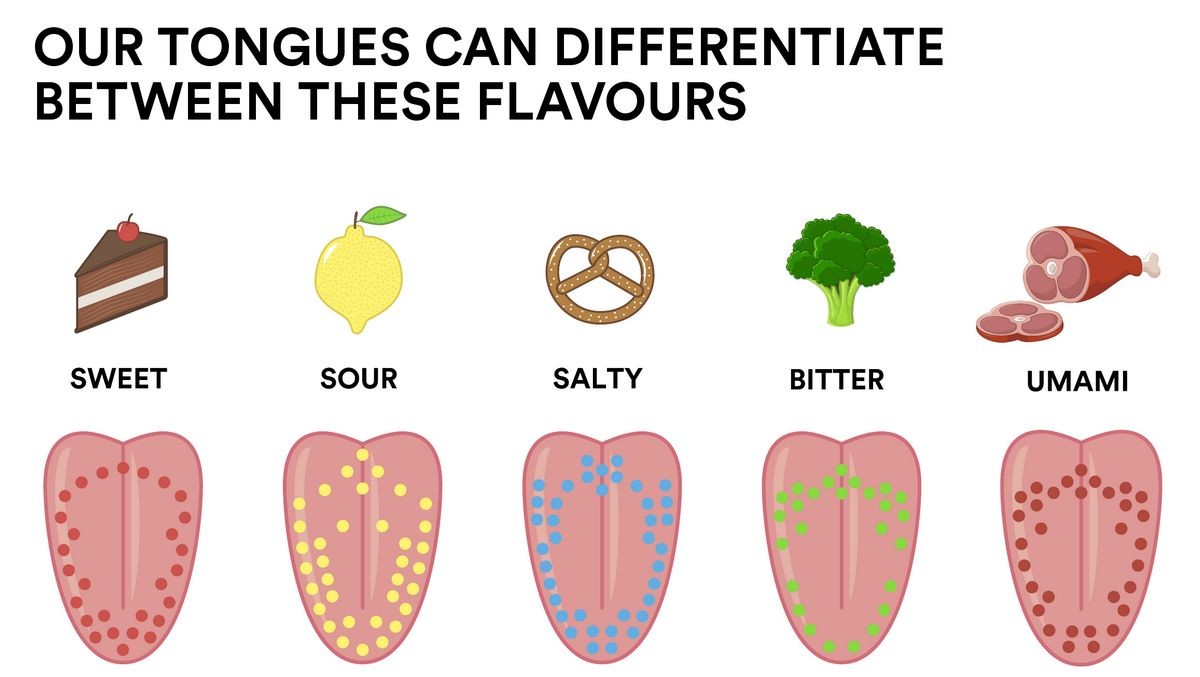
Contents
- 1 What Are Taste Buds? 5 Basic Tastes
- 1.0.1 How many taste buds are in the tongue?
- 1.0.2 Where are the taste buds located?
- 1.0.3 What are the 5 basic tastes?
- 1.0.4 How does the brain detect taste?
- 1.0.5 What causes taste buds to change?
- 1.0.6 What causes a loss of taste?
- 1.0.7 How can I get my taste back?
- 1.0.8 What disorders can affect your taste buds?
What Are Taste Buds? 5 Basic Tastes
Taste buds are sensory organs found on the tongue that detect tastes such as salty, sweet, sour, bitter, and savory. These organs have nerve endings that send messages to your brain and allow you to experience different tastes.
How many taste buds are in the tongue?
The average tongue has between 5,000 and 10,000 taste buds.
When food dissolves in your saliva, it activates receptors at the tips of the cells that distinguish between different types of tastes. The receptors then send signals to the brain, relaying the precise flavor you are experiencing.
Where are the taste buds located?
Most taste buds are found in papillae (small, rounded bumps on the tongue). Taste buds can also be found on the roof of the mouth and at the back of the throat, which are replaced with new taste buds every 8 to 12 days.
There are four types of papillae on the tongue:
- Fungiform papillae: These have a slight mushroom-like shape and are mostly found at the apex (tip) of the tongue and on the sides.
- Filiform papillae: These are thin, long V-shaped papillae cones that lack taste buds but are the most numerous.
- Foliate papillae: Ridges and grooves found on the lateral margins of the tongue toward the back.
- Circumvallate papillae: Dome-shaped structures on the back surface of the tongue, each containing over 100 taste buds.
For a long time, scientists believed that each taste was identified at a different location on the tongue. However, subsequent research has proven this to be false. Although the edge of the tongue has more taste buds than the base and is more sensitive, the tongue does not have different areas of taste. The bitter taste is an exception because it is mostly found at the back of the tongue.
What are the 5 basic tastes?
The universally accepted basic tastes are:
- Sweet: A pleasurable taste that indicates the presence of sugar.
- Salt: The most basic taste receptor in the mouth.
- Sour: Detectable acidity of citrus fruits and fermented foods.
- Bitter: The most delicate of the five flavors.
- Umami: Described as savory or meaty.
Taste buds can also detect fatty, alkaline, and metallic tastes. Fats are an important part of a healthy diet, and there may be taste buds that are particularly sensitive to fatty flavors. The alkaline taste is derived from briny foods or liquids and is thought to be the opposite of sour. However, no conclusive research on these tastes exists.
QUESTION
How does the brain detect taste?
Each taste receptor on the tongue recognizes different tastes. They have microscopic hair-like proteins called microvilli that attach to chemical compounds according to taste. These cells link to taste-related neurons deep inside the tongue tissue, which connect them to the nervous system.
- Food breakdown: Your tongue breaks down food into its chemical-building components.
- Chemical involvement: Basic food molecules wash over the tongue and reach taste receptors, interacting with substances that match their taste specialty.
- Signals to the brain: Taste receptor cells activate neurons after binding to a food molecule, providing electrical impulses to the brain.
- Olfactory sensors: Chewing produces gaseous food chemicals that reach the nasal cavity, communicating complex flavor profiles to the brain.
- Information: Taste receptor signals reach the lower brain stem before entering the conscious brain.
Enhanced taste impulses join with smell signals in the brain to inform about the flavor in the mouth. If the brain perceives the flavor as good, it stimulates the production of saliva and stomach secretions, facilitating digestion and making certain foods more appetizing.
What causes taste buds to change?
Taste buds die and regenerate every couple of weeks. Causes of change in taste buds include:
- Trauma: Burning or biting your tongue eliminates taste buds.
- Age: Slower regeneration of taste cells as you get older.
- External factors: Certain medications, chemotherapy, or radiation can temporarily cause taste bud loss.
What causes a loss of taste?
Anosmia, a loss of smell, is often associated with a loss of taste. Typically, swelling and excessive mucus in the sinuses block the nerve endings in the nose that detect odors. Because smell and taste are linked, people often report their symptoms as a loss of taste.
Possible causes of loss of taste and smell include:
- COVID-19: Loss of taste and smell is a common symptom of COVID-19.
- Upper respiratory infection: Inflammation and excess mucus can affect taste.
- Allergies (hay fever), sinusitis (sinus infection): Inflammation and mucus in the nasal cavities can cause loss of taste and smell.
- Other possible causes: Nasal polyps, medications, dental problems, cancer treatment, Alzheimer’s disease, multiple sclerosis, Parkinson’s disease, head injuries or trauma, and vitamin and nutrient deficiencies.
Most people regain their senses of taste and smell after addressing the underlying causes. If symptoms persist or a more serious condition is suspected, seek medical attention.
How can I get my taste back?
In many cases, loss of taste is a symptom of an underlying issue that can be resolved once the primary condition is treated. Tips for getting your taste buds back include:
- Get plenty of rest and drink warm fluids.
- Stay hydrated to reduce inflammation and mucus buildup.
- Use a nasal spray to help clear out your sinuses.
- If you have a cold, flu, or allergies, take appropriate medications.
- Practice proper oral hygiene.
These treatments can help regain the sense of smell and taste by temporarily reducing congestion that blocks smell sensors in the back of your nose.
What disorders can affect your taste buds?
Types of taste disorders
- Hypogeusia: Partial loss of taste
- Ageusia: Total loss of taste
- Dysgeusia: Taste distortion that may include an unpleasant or metallic taste.
Causes of taste disorders
Taste disorders can be caused by injury, illness, or present at birth. Other factors include:
- Head injury
- Radiation therapy
- Chemical exposure
- Surgeries to the ear, nose, and throat
- Poor oral hygiene and/or dental problems
- Upper respiratory and/or middle ear infection
Treating taste disorders
- Discontinuing or changing medications that cause the issue
- Treating the underlying medical condition
- Seeking counseling if the taste disorder cannot be adequately treated
By clicking Submit, I agree to the MedicineNet’s Terms & Conditions & Privacy Policy and understand that I may opt out of MedicineNet’s subscriptions at any time.
By clicking Submit, I agree to the MedicineNet’s Terms & Conditions & Privacy Policy and understand that I may opt out of MedicineNet’s subscriptions at any time.


